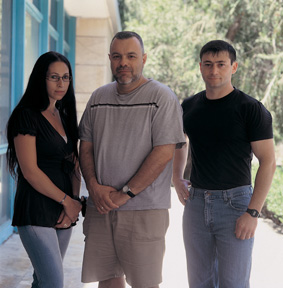Weizmann Institute scientists have discovered a mechanism that controls the sending of distress signals in the nervous system

The nerve cells that together form nerve fibers, such as those spread from the base of the spine to the entire length of the leg, sometimes reach a length of a meter. In other words, the extensions of nerve cells, the axons, can be 40,000 times longer than the width of the cell body. When such an axon is damaged, it sends molecular distress signals to the cell nucleus. For the molecule that transmits the distress signal, the journey from the injury site along the axon to the cell body is equivalent to the journey of a human messenger from one end of the country to the other.
Prof. Michael Feinzylver, from the Department of Biological Chemistry at the Weizmann Institute of Science, studies the communication systems of the emergency signal in nerve cells. In the past he was able to show that the distress signals are composed as a molecular structure that moves towards the nucleus on a sort of "rail" made of microtubules, which are part of the cytoskeleton. The dynein protein functions as a kind of motor, which together with "import proteins" ("importins") moves various molecules into the cell nucleus, and from there into the cell cavity. This is how the distress signals from the "field" reach the cell's control and command post.
But how does the mechanism that controls this communication system work after an injury? This was the question that preoccupied Prof. Feinsilver and the research students from his group, Dimitri Yudin and Shlomit Hentz, who worked together with members of Dr. Jeffrey Twiss' research group at the Nemours Institute in Delaware. They used the femoral nerves of rats as a research model, and looked for changes in the molecular composition of the cellular material around the nerve cell injury site. To their surprise, they discovered in the area of the injury molecules that until now were considered to be "residents" of the cell nucleus only. These molecules, known collectively as the Ran system, appear in two main configurations: one that is inside the nucleus, and the other is found mainly outside the nucleus, and helps the "importin" proteins to lead different molecules into the nucleus, and out of it, through a kind of gates in the nuclear membrane.
It turns out that the Ran molecule, which is usually found inside the nucleus, integrates into the molecular structure that is the distress signal that should be sent from the nerve fiber damage site to the cell body. The integration of the "nuclear" Ran molecule in the structure prevents the importin proteins from connecting to the structure and pulling it along the conveyor track. When an injury occurs, the "nuclear" Ran molecule becomes its extranuclear "sister", and it detaches from the molecular structure. At this stage the released structure binds to the importins, which begin to pull it up the axon, the long way to the cell body.
The scientists believe that the Ran system acts as a kind of security lock that prevents unwanted and unnecessary activation of the alarm system. In the event of a real emergency, the system quickly releases the lock, and enables distress signals to be sent. A better understanding of this mechanism may lead to the development of treatment methods that will help heal damage to nerve cells.
